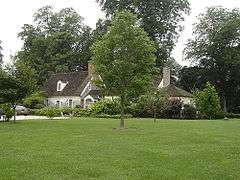Wye House
Wye House is a historic plantation house northwest of Easton in rural Talbot County, Maryland. Built in 1781–1784, it is a high-quality and well-proportioned example of a wooden-frame Southern plantation house. It was designated a National Historic Landmark in 1970.
Wye House | |
 Wye House mansion, seen from the front lawn | |
  | |
| Nearest city | Easton, Maryland |
|---|---|
| Built | 1784 |
| Architect | Key, Robert |
| Architectural style | Georgian, Federal |
| NRHP reference No. | 70000264 |
| Significant dates | |
| Added to NRHP | April 15, 1970[1] |
| Designated NHL | April 15, 1970[2] |

History
The Wye plantation was settled in the 1650s by a Welsh Puritan and wealthy planter, Edward Lloyd. Between 1780 and 1790, the main house was built by his great-great-grandson, Edward Lloyd IV.[3] It is cited as an example between the transition of Georgian and Federal architecture, which is attributed to builder Robert Key. Nearby the house is an orangery, a rare survival of an early garden structure where orange and lemon trees were cultivated, and which still contains its original 18th century heating system of hot air ducts.[4][5]
During its peak, the plantation surrounding the house encompassed 42,000 acres (17,000 ha) and housed over 1,000 slaves.[6] Though the land has shrunk to 1,300 acres (530 ha) today, it is still owned by the descendants of Edward Lloyd, now in their 11th generation on the property. Frederick Douglass was a slave on the plantation, from around the ages of seven and eight, and spoke extensively of the brutal conditions of the plantation in his autobiography, Narrative of the Life of Frederick Douglass, an American Slave.[6]
Modern situation
The nearby hamlets of Unionville and Copperville are where many descendants of the slaves who worked Wye House live today. This has created an interesting dynamic, considering the descendants of both the slave owners and the slaves still live within a very short distance of one another.[3][6][7]
The Wye House plantation gained significant media attention in 2006 for archaeological investigations led by the University of Maryland.[6][7]
In 2011, excavation of the greenhouse, built by African slaves, brought a discovery of African charms laid to ward off bad spirits at the house's furnace and entrance.[8]
See also
| Wikimedia Commons has media related to Wye House. |
- Chase–Lloyd House, a National Historic Landmark in Annapolis, Maryland, owned by the Lloyd family 1771–1847.
- List of National Historic Landmarks in Maryland
- National Register of Historic Places listings in Talbot County, Maryland
References
- "National Register Information System". National Register of Historic Places. National Park Service. January 23, 2007.
- "Wye House". National Historic Landmark summary listing. National Park Service. Retrieved June 17, 2008.
- Ydstie, John (October 20, 2007). "Plantation Dig Reveals Md. Town's Painful Past". National Public Radio. Retrieved February 7, 2008.
- "Orangery at Wye House". D.O. Garden Stories. Retrieved October 27, 2018.
- "Wye House, Orangery, Bruffs Island Road, Tunis Mills, Talbot County, MD". Historic American Buildings Survey. 1936.
- Wilford, John Noble (September 6, 2006). "An Abolitionist Leads the Way in Unearthing of Slaves' Past". The New York Times. Retrieved July 13, 2007.
- Williamson, Elizabeth (July 21, 2006). "Unearthing Slavery, Finding Peace". The Washington Post. Retrieved July 13, 2007.
- Dominguez, Alex (February 13, 2011). "Slaves hid African charms on Colonial greenhouse". San Francisco Chronicle. Associated Press. Retrieved February 14, 2011.
External links
- Where Land and Water Intertwine: An Architectural History of Talbot County
- Wye House, Talbot County, including undated, at Maryland Historical Trust
- Williamson, Elizabeth (July 21, 2006). "Unearthing Slavery, Finding Peace". The Washington Post. Retrieved July 13, 2007.
- Wilford, John Noble (September 6, 2006). "An Abolitionist Leads the Way in Unearthing of Slaves' Past". The New York Times. Retrieved July 13, 2007.
- Wye House, Mansion, Bruffs Island Road, Tunis Mills vicinity, Talbot, MD at the Historic American Buildings Survey (HABS)
- Wye House, Captain's House, Bruffs Island Road, Tunis Mills vicinity, Talbot, MD at HABS
- Wye House, Cemetery, Bruffs Island Road, Tunis Mills vicinity, Talbot, MD at HABS
- Wye House, Corn Crib, Bruffs Island Road, Tunis Mills vicinity, Talbot, MD at HABS
- Wye House, Orangery, Bruffs Island Road, Tunis Mills vicinity, Talbot, MD at HABS
- Wye House, Smokehouse, Bruffs Island Road, Tunis Mills vicinity, Talbot, MD at HABS

